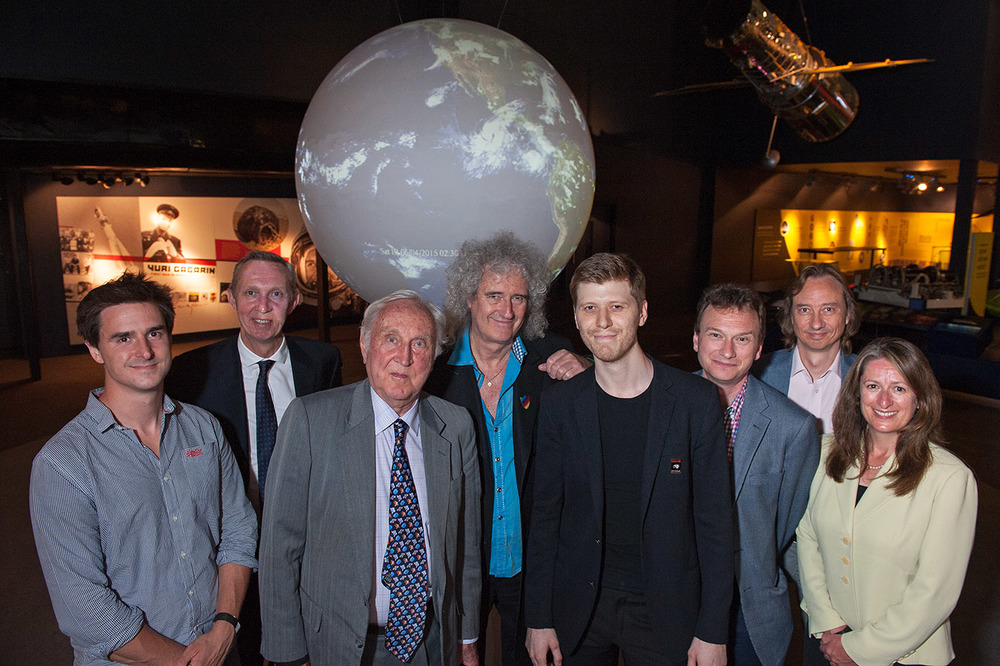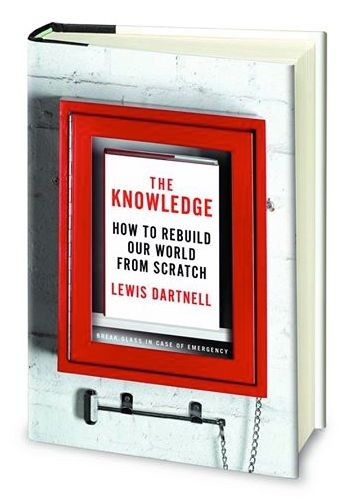How to Survive an asteroid strike
 One of the possible hazards that could collapse civilisation is an asteroid impacting the Earth. This June I was involved in the launch of Asteroid Day, an international effort to raise awareness and begin a measured discussion on the potential threat posed by asteroids. The event at the Science Museum in London was organised by Grigorij Richters and also included Lord Martin Rees, Brian May, Stuart Clarke, Sir Crispin Tickell, Prof Richard Crowther, Prof Alan Fitzsimmons, and Debbie Lewis. In this guest blog post below, we have Debbie Lewis discussing how it is possible to survive a Near-Earth Object (NEO) impact event. Debbie is a Fellow of the Emergency Planning Society and a Director for Resilience Preparedness.
One of the possible hazards that could collapse civilisation is an asteroid impacting the Earth. This June I was involved in the launch of Asteroid Day, an international effort to raise awareness and begin a measured discussion on the potential threat posed by asteroids. The event at the Science Museum in London was organised by Grigorij Richters and also included Lord Martin Rees, Brian May, Stuart Clarke, Sir Crispin Tickell, Prof Richard Crowther, Prof Alan Fitzsimmons, and Debbie Lewis. In this guest blog post below, we have Debbie Lewis discussing how it is possible to survive a Near-Earth Object (NEO) impact event. Debbie is a Fellow of the Emergency Planning Society and a Director for Resilience Preparedness.

Is it Really Possible to Survive a Near-Earth Object (NEO) Impact Event?
The short answer is, yes, it is possible to survive, provided that effective risk management strategies are completed well before an object, on a collision course with the Earth, is identified.
In 2010 the National Academy of Sciences Final Report identified four risk treatment methods to mitigate the NEO hazard. These are: characterisation, civil protection, planetary defence and the establishment of a research programme. In reality, mitigation of the risk posed is probably going to involve the adoption of more than one technique, mainly as a measure of confidence. Whichever method for mitigation is used it is considered that the strategy for civil protection will always form part of the response, either as the main response or as a contingency[1].
There have been a number of space-based missions that have taken place for characterisation purposes, in order to ascertain the composition of individual asteroids and to determine mitigation strategies. The most effective method for mitigation is to deflect the NEO’s orbit away from the Earth’s orbit. In reality, as yet, the technology is not available however it could be developed if an object was discovered with several years warning. Essentially, the only available response at this time is being able to predict where an object will strike the Earth and making the arrangements for civil protection such as planning for a mass evacuation of the area .
I appreciate that over seventy percent Earth’s plant and animal species, including the dinosaurs, were wiped out after the asteroid impact event 65 million years ago, at Chicxulub, in Mexico. However, human beings do not have to suffer the same fate as the dinosaurs as between ten and thirty per cent of the mammal population, at that time, survived. Their survival is attributed to living underground prior to the event occurring and consequently all their food supplies were also stored underground. As such not only were they able to survive the explosion from the impact of the asteroid as it crashed into the Earth, but they were also able to continue to support themselves as neither their homes nor their stock-piled food supplies were destroyed.
In addition to basic survival, there are wider aspects of civil protection planning such as the potential disruption to essential services as a result of the damage sustained to the national infrastructure which needs to be taken into consideration1. Within the United Kingdom the following nine infrastructure sectors have been identified: communications, emergency services, energy, finance, food, government, health, transport and water . Clearly these sectors need to continue to be provided following a NEO impact event. Social systems also need to be designed to be more robust and resilient in order to improve resistance to such impact events.
Contingency planning for successful evacuation and preservation of critical infrastructure needn’t necessarily involve a reinvention of the wheel if other facilities and arrangements are already in existence. Therefore a possible survival strategy, for a NEO impact event, could give consideration to the construction and utilization of existing underground shelters. These shelters would then be equipped with the necessary resources, such as modern technology and provisions, in order to sustain communities not only throughout the disruption but also during the associated societal disintegration and through the transition phase to a post-crisis civilisation . Depending on the severity of the impact this could be required for several months or even a number of years.
Similar arrangements have already been developed in response to the threat from the Cold War[5]. Although nuclear shelters had not been planned for the occurrence of life threatening situations, such as those resulting from natural disasters, these shelters could be adapted for this purpose. Further deliberation could be given to creating shelters in disused mines, sufficiently supplied with provisions with safety mechanisms for surface monitoring along with secure access and egress points.
Potentially then underground sanctuaries could contain numerous resources with which to ensure an effective return to a productive society such as equipment, seeds and other products. Materials could be stored and protected, such as books from libraries and artefacts from museums. Further consideration could also be given to the inclusion of hunter-gatherers and subsistence farmers along with the equipment they consider to be beneficial[5].
The National Academy of Sciences Report1 additionally recognizes the importance of socio-political decision making not only in determining which mitigation techniques require development, but also on the probability that mitigation is deemed to be required. Crisis scenarios can be contemplated in advance in order to better inform decision making for the response.
Additionally, governments might fund organisations in order to set aside products in preparation for a crisis. However, the rarity of an impact event occurring means that it is difficult to determine which strategy will be effective in the response to this situation. Although the likelihood of a natural, catastrophic NEO impact event occurring is low, this should not deter the development of risk management strategies in order to minimise the threat to human life and reduce the devastating effects which result. The consequences of previous impact events can be seen to be similar to those presented by the most devastating natural hazards, such as earthquakes and tsunamis, yet our concern for the NEO impact hazard seems to be at a disproportionately relaxed level.
[1] National Academy of Sciences (2010) Defending Planet Earth: Near-Earth Object Surveys and Hazard Mitigation Strategies: Final Report. Washington: The National Academies Press; available online at www.nap.edu/catalog/12842.html; date accessed 28 June 2010
[2] Atkinson, H., Tickell, C., and Williams, D. (2000) Report of the Task Force on Potentially Hazardous Near Earth Objects. London: British National Space Centre; available online at http://www.nearearthobject.co.uk; accessed 28 March 2009.
[3] Barstow, M. (2010) Telephone conversation to the author, 6 December
[4] Centre for the Protection of National Infrastructure. (2011) What is the Critical National Infrastructure?; available online at http://www.cpni.gov.uk/about/what-is-the-CNI/ accessed 17 Februrary 2011
[5] Napier, W. (2008) „Hazards from comets and asteroids‟, In Bostrom, N., Cirkovic, M.M. (Eds) (2008) Global Catastrophic Risks. Oxford: Oxford University Press 222-237
Debbie Lewis received her MSc in Risk Crisis and Disaster Management from the University of Leicester in 2011. Her dissertation was entitled, “Near-Earth Objects: Imminent Catastrophe or Manageable Risk?” The scope of the dissertation dealt with the risks, to Earth, posed by Near Earth Objects (NEO) along with the existing capabilities for tracking NEO in addition to risk communication and warning the public if an Earth strike is predicted. The dissertation demonstrated and articulated the void that currently exists in the risk management planning, on multiple levels, for NEO events.
She has also created and conducted disaster management exercises for the International Academy of Astronautics Planetary Defence Conferences (IAA PDC) 2013 in Flagstaff, Arizona and in Frascati, Italy in April this year. Debbie has also provided civilian health service, emergency planning subject matter expertise to the NATO Joint Warfare Centre.
Previously Debbie was the consultant tutor responsible for producing the course materials and for the delivery of the Diploma in Health Emergency Planning Programme for Loughborough University. Prior to establishing Axiom (Alderney) Ltd, Debbie also formed part of the team of associate lecturers delivering the Diploma in Health Emergency Planning on behalf of the UK Government’s Emergency Planning College and the Health Protection Agency.

